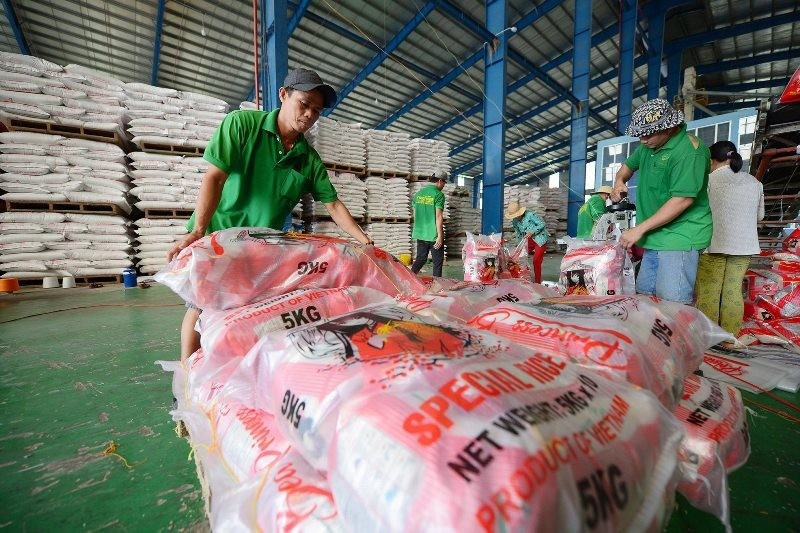Market fluctuations challenge Viet Nam’s rice export sector
Since the beginning of 2025, Viet Nam’s rice export prices have steadily declined, currently falling below 390 USD per tonne. The rice export industry is grappling with a dual challenge: shrinking global demand and abundant, competitively priced supply from numerous countries.

According to Phung Duc Tien, Deputy Minister of Agriculture and Environment, in the first five months of 2025, Viet Nam exported 4.5 million tonnes of rice, generating 2.34 billion USD. This marks a 12.2% increase in volume but an 8.9% drop in value compared to the same period in 2024. The main cause lies in falling export prices, which averaged 516.4 USD per tonne — down 18.7% year-on-year. The Philippines was Viet Nam’s largest rice importer, accounting for 41.4% of the market, followed by Ivory Coast with 11.9%.
In just the first four months of 2025, the value of rice exports to the Philippines dropped by 21.8%, while exports to Indonesia plummeted by 97.9%. However, exports to China are regaining momentum, making it Viet Nam’s third-largest export market in the first five months of 2025 with a 10.3% share. Export value to China rose by 83.7% over the four-month period. In Bangladesh, the value of rice exports surged by 515.6 times.
“Given the declining value of rice exports in traditional markets and shifting import demands in several countries, the rice sector must continue diversifying its markets and seeking new, high-potential destinations. The focus should be on high-quality, aromatic, and specialty rice — categories that retain stable pricing due to increasing consumer demand,” emphasised Deputy Minister Phung Duc Tien.
In reality, Viet Nam’s major rice importers — the Philippines and Indonesia — are actively seeking self-sufficiency in rice production, which will limit their import demand.
According to the Viet Nam Food Association, Indonesia’s rice output in the first half of 2025 is expected to reach 32.57 million tonnes (equivalent to about 18.8 million tonnes of milled rice), up 11.2% year-on-year. The country has revised its 2025 rice production forecast upwards to over 34 million tonnes, from the earlier projection of 32 million tonnes. If output exceeds the national demand of 31 million tonnes, exports may be allowed. Meanwhile, the Philippines’ growing rice reserves are also reducing the need for imports.
Although Viet Nam’s rice exports to China have grown in early 2025, competition from Thailand and Cambodia — offering comparable quality and packaging — remains intense. Meanwhile, India, the world’s largest rice exporter, continues to expand its export volume. From April 2024 to March 2025, India exported 19.865 million tonnes of rice, up 21.4% year-on-year.
In response, Vietnamese rice exporters are implementing various strategies to adapt to fluctuations in both domestic and global markets.
Nguyen Tuan Khoa, Deputy Director of Phuoc Thanh II Co., Ltd. (Long An), acknowledged the persistent challenges, particularly regarding export prices. Since early 2025, the company has exported more than 10,000 tonnes of rice, primarily to Singapore, the Philippines, and Malaysia. However, as rice production rebounds in many countries, Viet Nam is facing stiffer competition.
To sustain export orders and improve prices, the company is exploring new markets in Africa, the Middle East, and high-end segments. It is also focusing on quality by working with farmers to cultivate premium rice varieties that are in demand internationally, and promoting clean, green farming practices.
Looking forward, the company intends to join the national programme “Sustainable Development of One Million Hectares of High-Quality, Low-Emission Specialised Rice Cultivation Linked to Green Growth in the Mekong Delta by 2030” to produce low-carbon rice, which is attracting interest from consumers in many countries.
Chon Chinh Import-Export Co., Ltd. (Dong Thap), recognised under the project for its low-emission rice cultivation, is focused on producing and exporting high-quality, low-emission rice to new markets in Europe and the Middle East. The company continues to upgrade production lines to boost efficiency, lower emissions, and minimise environmental impact. In 2025, it plans to produce 200,000 tonnes of rice, of which 180,000 tonnes will be exported.
Le Thanh Tung, Vice Chairman and Secretary-General of the Viet Nam Rice Industry Association (Vietrisa), noted that the country’s rice strategy will continue to prioritise high-quality, low-emission rice amid global market challenges.
Recently, Viet Nam shipped its first batch of “Green low-emission Vietnamese rice” to Japan, opening new international market opportunities. According to Vietrisa, seven enterprises have already been certified under the programme “Sustainable Development of One Million Hectares of High-Quality, Low-Emission Specialised Rice Cultivation Linked to Green Growth in the Mekong Delta by 2030.”








